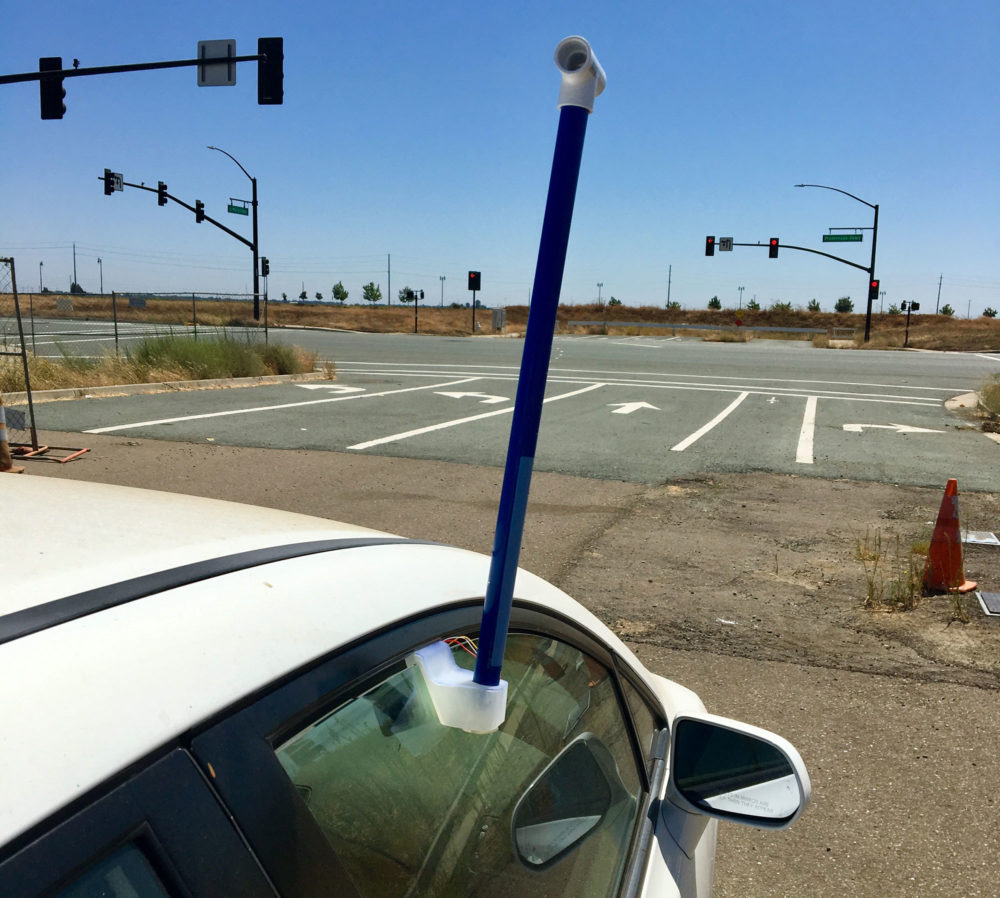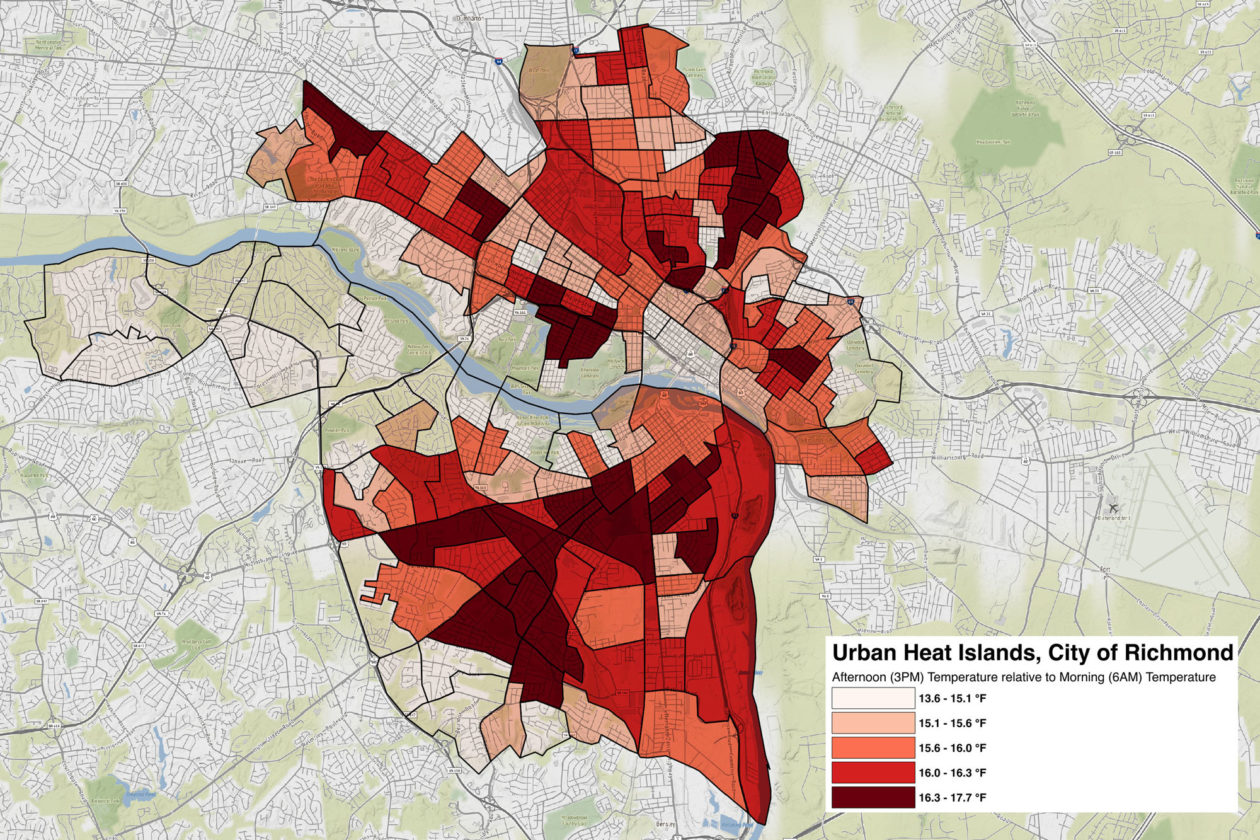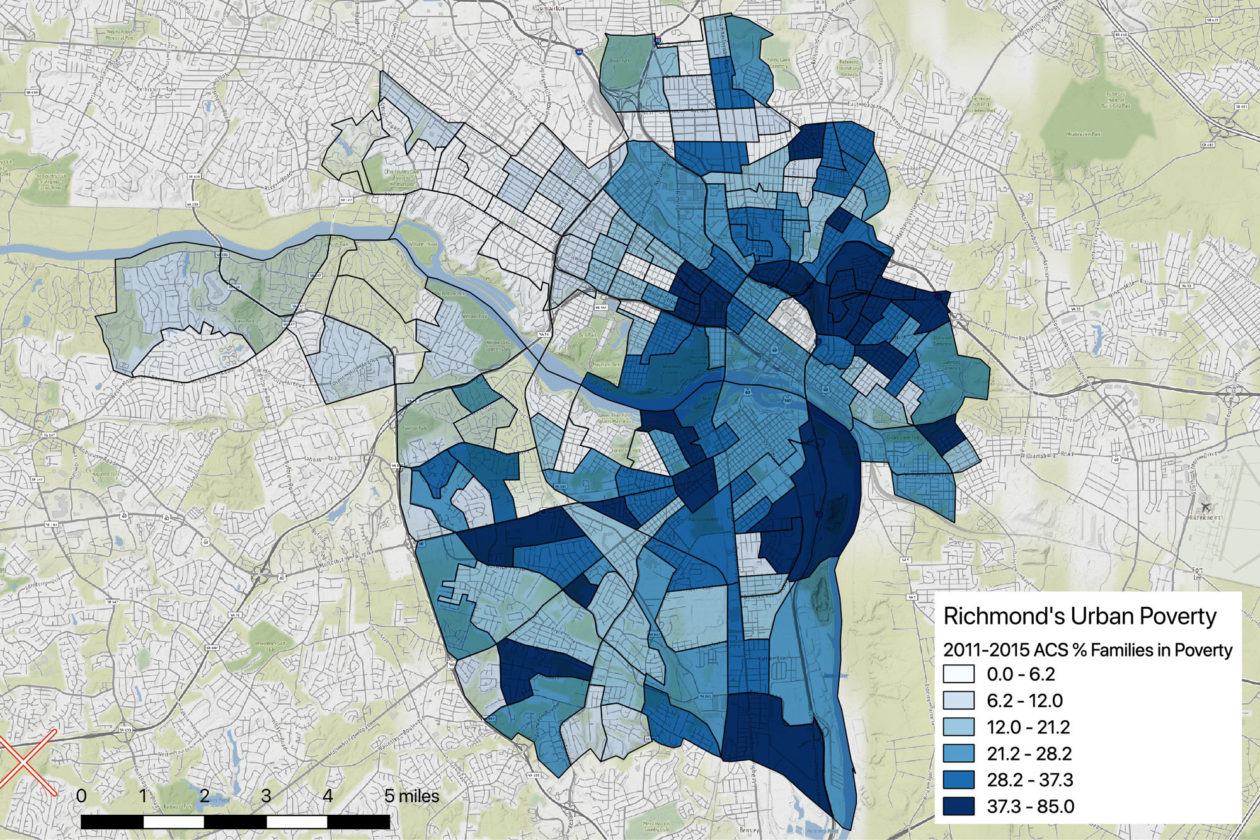How can we turn down the temperature on urban heat islands?
Using citizen science volunteers, researchers are more accurately measuring temperature differences between city hot spots and their cooler surroundings. With heat waves intensifying, the results are now being used to develop a range of innovative urban planning strategies.
T
he volunteers fanned out across cities from Boston to Honolulu this summer, with inexpensive thermal monitors resembling tiny periscopes attached to their vehicles to collect data on street-level temperatures. Signs on their cars announcing “Science Project in Progress” explained their plodding pace — no more than 30 miles-per-hour to capture the dramatic temperature differences from tree-shaded parks to sun-baked parking lots to skyscraper-dominated downtowns.
The work of these citizen scientists is part of a new way of studying the urban heat island effect, with volunteers mapping two dozen cities worldwide in recent years. Past studies of urban heat islands — in which metropolitan areas experience significantly higher temperatures than their surroundings — have relied on satellite data that measures the temperature reflected off rooftops and streets. But Vivek Shandas, a professor of urban studies and planning at Portland State University in Oregon and a researcher leading the project, says the urban heat island effect is more complicated and subtler than satellite data indicates.
“There’s much more nuance within the city,” Shandas says. “What we’re finding is that there’s upwards of 15- to 20-degree Fahrenheit differences within a city. In fact, a city could have the same temperature reading in one area as its rural or forested counterpart.”
By understanding in detail where hot spots are located, cities can address extreme heat neighborhood-by-neighborhood, choosing from a variety of strategies that include removing or whitewashing black asphalt or roof surfaces, adding more trees for shade, requiring developers to vary the heights of new buildings to increase airflow, and opening more public air-conditioned spaces.
Using Shandas’ research, Portland, the first city Shandas and his team surveyed, has proposed zoning code amendments and strategies targeting urban heat, including limiting paved neighborhood parking areas and increasing space for trees. In addition, city officials said that Shandas’ on-the-ground data clearly demonstrated a correlation between lower-income neighborhoods and higher temperatures. Shandas’ work also showed that the places where lower-income people often work, such as the industrial areas along Portland’s rivers, also experience higher-than-average temperatures, the officials said.
Other urban heat island studies have shown that the hottest places in metropolitan areas are often in poor, minority neighborhoods with few trees, and this research can provide a framework for city planners to address the problem.
Shandas and his teams have mapped 24 cities in the United States and worldwide, including Albuquerque; parts of the Vancouver metropolitan area; Hong Kong; Doha, Qatar; and Hermosillo, Mexico. In the past, urban heat island studies relied on data from satellites or stationary sensors, but Shandas’ appears to be the first enlisting citizen scientists to collect temperature data using mobile sensors.
Researchers have studied urban heat island effects in every major country from Australia, where a government study warned that heat wave deaths would quadruple by 2050, to China, which has more than 40 cities with populations exceeding 2 million people. Globally, heat is the number one weather-related killer, causing more deaths each year than floods, tornadoes, or hurricanes. Extreme heat can kill directly via heat stroke and indirectly through increased risk of heart attack and stroke. Climate models show that in some cities the number of high-heat days could double by 2040.
This summer’s heat wave in Europe, with temperatures soaring to a record-breaking 46 degrees Celsius (115 degrees F) in the south of France, killed 1,500 people in France alone, the French health minister said this week. Russian officials reported that a 2010 heat wave killed 11,000 people in Moscow. The rise in overall global temperature makes extreme heat events, including consecutive days of high heat, more likely. Mitigating extreme heat, one recent study says, would save lives.
Urban heat islands have been generally understood since large cities began to emerge in the 19th century, but research by Shandas and others reveals a complicated patchwork of hot spots and cool spots that change during the course of a day and are determined by urban design. Satellite data, for instance, showed midtown Manhattan to be an afternoon hot spot. But mapping unveiled a different picture.
“When you actually go down to the ground, where people are walking and life is happening, it turns out it’s not the same signal,” Shandas says.
The long shadows of Manhattan skyscrapers, for example, can make parts of that borough cooler in summer than some neighborhoods in Queens, which generally has low-rise buildings. On the other hand, midtown Manhattan retains heat and starts the day much warmer because the heat that’s absorbed by buildings, roofs, streets, and sidewalks during the day doesn’t dissipate as well at night.
“It’s the built environment that we’re really trying to understand because, ultimately, we’re trying to adapt the landscape to respond to this increasing frequency, intensity, and duration of heat wave,” Shandas says. “We’re trying to get more precise data. And there were so many surprises.” A large expanse of water, for instance, or grass that is not watered, can be almost as hot as concrete, he says.
Jaime Madrigano, a researcher with the RAND Corporation who has studied urban heat, praised the way Shandas and his colleagues were using citizen science volunteers and “getting the community engaged in the issues around extreme heat… I think there are a lot of cities that are trying to make these changes. This kind of data is really important to doing that.”
Shandas grew up in Bangalore, and during visits there and to other cities in India he began thinking about how cities have developed without regard for the increasing incidence of extreme weather events linked to climate change, including heat waves. He began his research with a bit of engineering, using a National Science Foundation grant to reach out to engineers who helped create the hand-made instrumentation that transmits data. With funding from the U.S. National Oceanic and Atmospheric Administration, he first mapped Portland in 2015.

A mobile sensor collects temperature data in suburban Sacramento this summer. COURTESY OF VIVEK SHANDAS
A breakfast in Portland the next year with Jeremy Hoffman, who had just accepted a job as the climate and earth scientist at the Science Museum of Virginia, led to a partnership and citizen-science projects mapping Richmond, Baltimore, and Washington, D.C.
Those partnerships with local groups have been invaluable, says Hoffman. “It was really useful to have the local perspective” while creating the mapping routes, Hoffman says. “Where is the park that everybody goes to? Where are they going to redevelop over the next couple of years? That kind of knowledge made our campaigns not only scientifically useful, but publicly attractive. It was the people themselves getting involved; it wasn’t just the scientists.”
The studies correlated data to the tenth of a degree from sensors on vehicles that followed a series of one-hour, zigzag routes — early morning, mid-afternoon, and early evening — driven by volunteers recruited by local science museums, universities, and non-profits. Fifteen teams mapped Richmond during a summer weekend in 2017. One park along the James River measured 87 degrees F, while a few miles away, along a four-lane roadway, it was 103 degrees.
Shandas and Hoffman say their work demonstrates that extreme heat is a social justice issue. In Richmond’s hottest areas, they found a higher concentration of poverty and of 911 calls for heat-related illnesses. Mapping last year in Washington, D.C. and Baltimore found a similar correlation, with higher temperatures in lower-income neighborhoods largely barren of trees and lower temperatures in more affluent, tree-shaded areas. Shandas and Hoffman recently completed a paper, due to be published soon, comparing redlined neighborhoods — those once illegally designated by lenders as too risky to make home loans — with extreme urban temperatures. “The big take-home point for the paper is that 92 percent of the cities that were redlined are now warmer than their A-rated neighbors,” Hoffman says. “This seems like it’s predominantly due to a lack of green and a dominance of gray.”

The differences in morning and afternoon temperatures in Richmond, Virginia. COURTESY OF JEREMY HOFFMAN

Poverty levels in Richmond. Lower-income neighborhoods often experience the worst heat in the city. COURTESY OF JEREMY HOFFMAN
Shandas says the research has uncovered six things that affect urban heat. Three are living — the volume of the tree canopy, the height of the tree canopy, and the ground level vegetation. Three are human-built — the volume of buildings, the difference in building heights, and the coloring of the buildings.
There were some surprises, he says. The volume of buildings can have both a negative and positive effect. Tall buildings that cast shade lower relative afternoon temperatures, while a large volume of shorter buildings, like the big-box stores in suburban areas, help generate hotter afternoon temperatures. Ground-level vegetation doesn’t necessarily reduce temperature — it’s not that much cooler than asphalt — unless it’s watered. Shandas also has found that increasing the difference in building heights in an area creates more air circulation, which has a cooling effect.
Creating cooler cities doesn’t necessarily mean building at lower densities. What matters, he says, is varying building heights, the canopy cover, and street widths. “It wasn’t about no buildings and all green,” he says. “It was about designing our spaces more thoughtfully.”
Some cities are already using the detailed research to guide decisions. In Richmond, a heat map and a vulnerability map showing those more at risk appear in reports for housing, transportation, and the climate action plan, and the city’s comprehensive master plan calls for reducing urban heat. Richmond hasn’t invested in planting trees yet, he adds, but citizen-science groups like Groundwork RVA and the museum have developed programs such as Throwing Shade in RVA, a program teaching students about urban heat that has led to them planting peach trees at local high schools and designing shady structures for neighborhood bus stops.
Groundwork RVA’s parent organization, Groundwork USA, has funding to expand on this work for a Climate Safe Neighborhoods project exploring the relationship between historical race-based housing segregation and the impacts of climate change in Denver, Colorado; Elizabeth, New Jersey; Richmond, California; and Pawtucket, Rhode Island.
Even at higher latitudes, heat is an issue. According to the Centers for Disease Control, some of the deadliest heat waves in recent decades have taken place in northern cities like Chicago, where people are not accustomed to extreme heat and more residences lack air conditioning. A five-day heat wave in Chicago in 1995 led to the deaths of 739 people.
In Portland, Shandas has created heat maps containing demographic information including age, race, education, poverty level, and education. The city is focusing its efforts in areas where urban heat islands and indicators of vulnerability, including low-income levels, overlap. Shandas’ work is reflected in Portland’s Better Housing by Design zoning update, in which the city has proposed zoning amendments to reduce urban heat island effects, including limiting surface parking areas in residential neighborhoods and requiring landscaped setbacks between buildings and streets to provide more space for trees.
His next step is to expand heat island mapping to 50 cities in 2020. The key question, he says, is whether cities will begin making the changes necessary to decrease deaths from extreme heat.
“Those are very preventable deaths,” Shandas says. “We can identify those locations and ameliorate some of the effects. It ultimately comes down to how to help these people. We have the technology.
The ideas presented in this article aim to inspire adaptation action – they are the views of the author and do not necessarily reflect those of the Global Center on Adaptation.